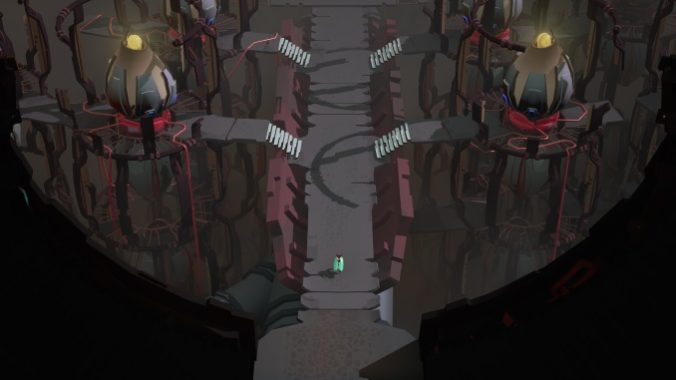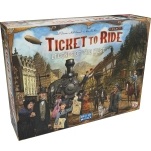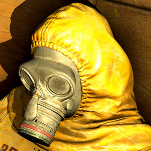Cocoon Is a Brain-Bending Cosmic Journey
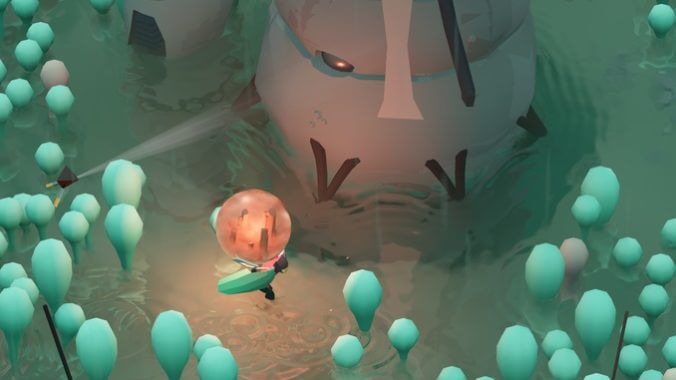
Surrounded by relics of unknown design, a little moth-person goes about their tasks. They travel through fleshy subterranean caverns, ochre cliffsides, and placid swamps, these disparate spaces connected by ancient technology and an overriding sense of purpose. Littered throughout are contraptions that block their progress until some discovery in a far-off place reveals the path forward. At first, you’re not sure why the protagonist does what they do, but an invisible hand guides their (and our) actions as we journey deeper into these unfathomable surroundings.
This is the world of Cocoon, a clever isometric puzzler that’s the freshman effort from indie outfit Geometric Interactive, founded by ex-Playdead (Limbo, Inside) employees Jeppe Carlsen and Jakob Schmid. Although their latest overlaps with their past work, particularly in its non-verbal storytelling and focus on atmospheric vistas, it finds its own identity through a focus on layered spaces that peel away to reveal ingenious puzzles and revelations.
A moment early on succinctly demonstrates its nested design and greater air of mystery. While exploring the canyons of its initial biome, you come across a metallic pad that looks out of place. You step on it, small plump tendrils unfurling as an audio cue implies it can be interfaced with. As you do, the moth-person is abruptly slingshotted out of their surroundings, copper mesas shrinking in a blink as they’re suddenly surrounded by metallic walls. Behind them is an orange orb. Is it a portal to where they came from? Or, somehow, is this object the totality of that place? This cosmic sense of scale, of worlds nestled inside of worlds, is a constant throughline here, and you guide the moth-person as they find new spheres and traverse the domains within.
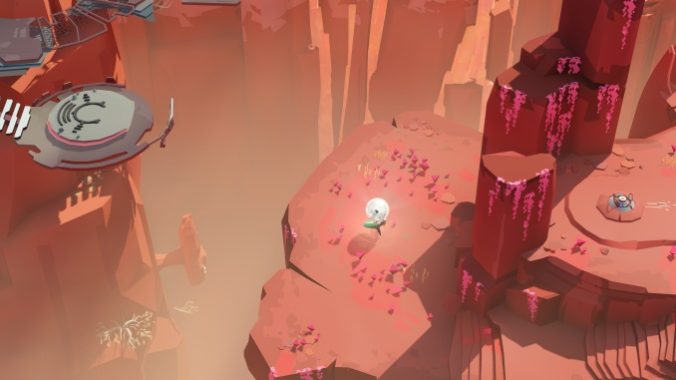
Initially, the puzzles you come across are relatively simple. After a little bit of reflection, you’ll probably be able to piece together that you’re supposed to use the orb to move platforms or awaken dormant crab-like machines to aid you. These early stretches glide by in a psychedelic haze, and even if you’re unlikely to be stumped for long, these challenges are slick and seamless enough to remain satisfying. However, before long, things delve into truly brain-bending territory. As you find additional orbs and, with them, new environments, you start to work through these worlds in parallel, discoveries in one letting you progress in the rest. It takes what originally comes across as a cool engineering trick—the nonexistent load times as you hop in and out of the orbs—and turns it into the core design principle of the entire experience as you use the relationships between these globes to progress.
Some orbs grant traversal abilities, like how the orange one projects crystalline paths, but these powers can only be used when carrying that particular sphere. Because just one can be held at a time, you must store them carefully, sometimes placing them inside each other to circumvent these limitations as you travel back and forth. While this sounds potentially overwhelming, this puzzle box is so well-engineered that even as its trials become more daunting, it never feels inscrutable. Part of this extends from the exceedingly simple control scheme (you only use the joystick and a single button), but the greater reason is that the game is an excellent teacher.
-

-

-

-

-

-

-

-

-

-

-

-

-

-

-

-

-

-

-

-

-

-

-

-

-

-

-

-

-

-

-

-

-

-

-

-

-

-

-

-

